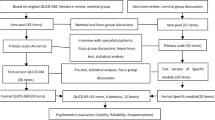Abstract
This study aims to evaluate the structural validity of the Community-Oriented Program for the Control of Rheumatic Diseases (COPCORD) core instrument as a screening tool for rheumatoid arthritis (RA) by means of assessing the existence of domains in the questionnaire. The Mexican version of the COPCORD instrument was applied to individuals over18 years of age in five regions of the country through a probabilistic/convenience household survey. Clinical confirmation of RA diagnosis was used. The variables analyzed included self-reported comorbidities and manifestations of the disease, as well as sociodemographic characteristics. The statistical approach was based on polychoric exploratory factor analysis and confirmatory factor analysis by means of probit structural equation models. A total of 19,213 subjects were included in the analysis. The average age for the total sample was 42.89 years old; 40.64 % of the subjects were older than 45 years of age and 20.42 % older than 55. More than 80 % of the variation was related to three underlying factors: recent pain, historical pain, and disability. The findings verified the usefulness of the COPCORD instrument as a screening tool for RA. The results also allowed to characterize how the variation in terms of manifestations of the disease could be accounted for diagnosing the disease in the Mexican context and examined the capabilities of the instrument to measure correctly the main characteristics of patients suffering from RA.

Similar content being viewed by others
References
Toledano E, Candelas G, Rosales Z et al (2012) A meta-analysis of mortality in rheumatic diseases. Reumatol Clin 8(6):334–341. doi:10.1016/j.reuma.2012.05.006
Lidgren L (2012) Looking back at the start of the bone and joint decade what have we learnt? Best Pract Res Clin Rheumatol 26(2):169–171
Goycochea-Robles MV, Sanin LH, Moreno-Montoya J et al (2011) Validity of the COPCORD core questionnaire as a classification tool for rheumatic diseases. J Rheumatol 38(suppl 86):31–35
Haq SA, Davatchi F, Dahaghin S et al (2010) Development of a questionnaire for identification of the risk factors for osteoarthritis of the knees in developing countries. A pilot study in Iran and Bangladesh. An ILAR-COPCORD phase III study. Int J Rheum Dis 13(3):203–214
Bennett K, Cardiel MH, Ferraz MB et al (1997) Cross cultural adaptation and screening characteristics of the COPCORD Core Questionnaire in Brazil, Chile, and Mexico. J Rheumatol 24:160–168
Peláez-Ballestas I, Sanin LH, Moreno-Montoya J et al (2011) Epidemiology of the rheumatic diseases in Mexico. A study of 5 regions based on the COPCORD methodology. J Rheumatol Suppl 86:3–8
Alamanos Y, Voulgari PV, Drosos AA (2006) Incidence and prevalence of rheumatoid arthritis, based on the 1987 American College of Rheumatology criteria: a systematic review. Semin Arthritis Rheum 36:182–188
Álvarez-Hernández E, Peláez-Ballestas I, Vázquez-Mellado J et al (2008) Validation of the Health Assessment Questionnaire disability index in patients with gout. Arthritis Rheum 59(5):665–669
Flora BD, Labrish C, Chalmers P (2012) Old and new ideas for data screening and assumption testing for exploratory and confirmatory factor analysis. Front Psychol 3:55–57
Foreo CG, Maydeu-Olivares A, Gallardo-Pujol D (2009) Factor analysis with ordinal indicators: a Monte Carlo study comparing DWLS and ULS estimation. Struct Equ Model A Multidiscip J 16(4):625–641
David BF, Curran PJ (2004) An empirical evaluation of alternative methods of estimation for confirmatory factor analysis with ordinal data. Psychol Methods 9(4):466–491
Satorra A, Bentler PM (1994) Corrections to test statistics and standard errors in covariance structure analysis. In: Von Eye A, Clogg C (eds) Latent variables analysis: applications for developmental research. SAGE, Thousand Oaks, pp 399–419
Yuan KH, Bentler PM (1998) Structural equation modeling with robust covariances. Sociol Methodol 28:363–396
Wirth RJ, Edwards MC (2007) Item factor analysis: current approaches and future directions. Psychol Methods 12:58–79
Scientific Software International, Inc (2012) LISREL: a general computer program for estimating a linear structural equation system involving multiple indicators of unmeasured variables (computer program). Scientific Software International, Inc., Chicago
StataCorp LP (2011) Stata statistical software (computer program). StataCorp, College Station
R Foundation for Statistical Computing (2012) R for Windows (computer program). R Foundation for Statistical Computing, Vienna
Roodman D (2011) Estimating fully observed recursive mixed-process models with cmp. Stata J 11(2):159–206
Uhm DC, Nam ES, Lee HY et al (2012) Health-related quality of life in Korean patients with rheumatoid arthritis: association with pain, disease activity, disability in activities of daily living and depression. J Korean Acad Nurs 42(3):434–442
Lesuis N, Befrits R, Nyberg F et al (2012) Gender and the treatment of immune-mediated chronic inflammatory diseases: rheumatoid arthritis, inflammatory bowel disease and psoriasis: an observational study. BMC Med 10:82
Blood EA, Cheng DM (2011) The use of mixed models for the analysis of mediated data with time-dependent predictors. J Environ Public Health 2011:435078. doi:10.1155/2011/435078
Acknowledgments
This project was supported by the funds provided by the Salud 2007-C01-69439 and Salud 2007-C01 69765 programs of the National Council of Science and Technology of México (CONACYT) and the Fundación Mexicana para Enfermos Reumáticos (FUMERAC).
Disclosures
None.
Author information
Authors and Affiliations
Corresponding author
Additional information
GEEMA (Grupo de Estudio Epidemiológico de Enfermedades Musculo Articulares): R. Burgos-Vargas, Hospital General de México, Faculty of Medicine, Universidad Nacional Autónoma de México, México City; MH Cardiel, Hospital Secretaría de Salud, Hospital General “Dr. Miguel Silva.”; L.H. Sanín, Universidad Autónoma de Chihuahua, Instituto Nacional de Salud Pública; M. Garza-Elizondo, Hospital Universitario José Eleuterio González; J. Rodriguez-Amado, Hospital Universitario José Eleuterio González; M.V. Goycochea-Robles, Unidad de Investigación, Colegio Mexicano de Reumatología; M. Madariaga, Hospital General de Culiacán, Secretaría de Salud; J. Zamudio, Hospital General de Culiacán, Secretaría de Salud; Natalia Santana Portillo, Instituto Mexicano del Seguro Social, Chihuahua.
Rights and permissions
About this article
Cite this article
Moreno-Montoya, J., Alvarez-Nemegyei, J., Trejo-Valdivia, B. et al. Assessment of the dimensions, construct validity, and utility for rheumatoid arthritis screening of the COPCORD instrument. Clin Rheumatol 33, 631–636 (2014). https://doi.org/10.1007/s10067-013-2367-3
Received:
Revised:
Accepted:
Published:
Issue Date:
DOI: https://doi.org/10.1007/s10067-013-2367-3




